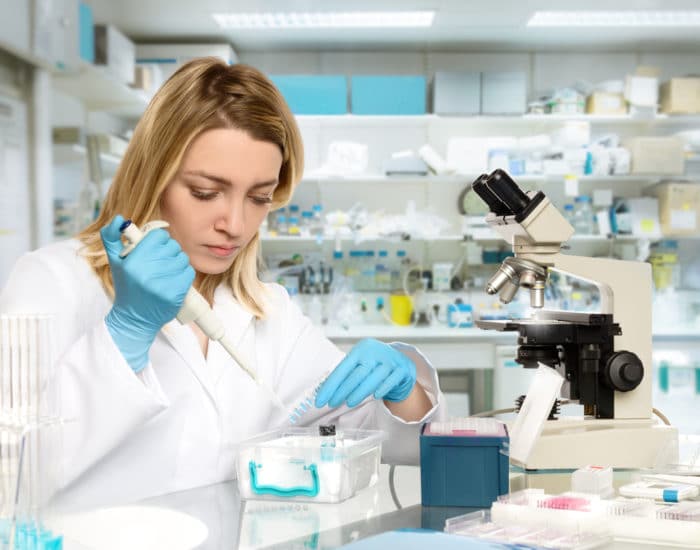Why We Love It
-
$93,730Potential Avg. Salary
-
8.2%Job Growth Rate
-
Growing DemandJob Outlook
-
Don't Take Work HomeCareer Attribute
A histologist is a technologist that works in medical libraries for research or diagnostic purposes. Their job is to effectively assess human tissue samples and determine various medical illnesses or abnormalities using specific chemicals.
Recommended Schools
What is a Histologist?
Duties
As a histologist, one has to undertake several important functions including the following:
- Stain, cut and study human tissue specimens using special or routine techniques to obtain data on how tissues and organs function effectively.
- Ensure that all medical procedures are in compliance with established standards and practices, by examining samples closely under a microscope.
- Work in close proximity with other professionals like diagnosticians and pathologists to assess patient symptoms via tissue and blood samples.
- Carries out maintenance and repairs of sophisticated laboratory instruments that are used to analyse tissue.
- Undertake advanced techniques such as immunohistochemistry and molecular testing for diagnostic reasons.
Day In The Life
There are several areas that histologists focus on during their day – chiefly, three main parts include staining, cutting and embedding. The day starts off with taking human tissue samples and preparing them for the pathologist to examine under a microscope. Your role requires efficient time management, superior communication skills and a high level of mastery regarding sample gathering techniques.
Using alcohol and other chemical solutions, you will remove the water and make the tissue thin and firm. Each thin tissue specimen is placed on glass slides and embedded in paraffin wax blocks or wax is inserted into them as an alternative. Operating precision equipment is a frequent requirement, as well as working with a diverse range of dyes or chemicals for noting visible abnormalities.
Work Schedule And Typical Hours
Histologists work for around 40 hours per week on a regular schedule or on shifts, depending on the workplace preference. The work environment is indoors but there is some risk such as exposure to hazardous equipment or conditions, contaminants and infections. You will most likely work in medical laboratories alongside other staff such as pathologists and laboratory experts. It is common to wear protective safety gear such as life jackets, goggles, gloves and safety shoes to protect oneself from any unforeseen threats.
Growth Of The Job
The demand for professionals in this job sector is expected to rise at 16% between 2014 and 2024. With an increasing population in the older demographic, the demand for procedures at diagnostic labs is bound to grow at a rapid pace. Further, with easier access to health insurance, more individuals are required in this field to detect, diagnose and treat various diseases.
Typical Employers
Histologists mainly work in labs and research areas, similar to other types of medical technicians. Job openings are available at hospitals, clinics, industrial research facilities, dermapathology lab, forensic pathology, marine biology, veterinary pathology and other public health facilities. Work at surgical departments versus general healthcare facilities requires quicker turnaround times due to tight deadlines for surgeons.
Typical employers include companies such as the following: Penn State Health Milton S. Hershey Medical Center, NeoGenomics Laboratories, Leidos Biomedical Research, Inc., University of Maryland Medical Center, Botsford Hospital, Medical University of South Carolina, Clinical Pathology Laboratories and so on.
Recommended Schools
How To Become a Histologist
To qualify for an entry-level position as a histologist, one needs to have a bachelor’s degree in medical technology or one of the life science subjects such as biology, chemistry, microbiology, etc. As a student, one also has to actively take part in internships and clinical rotations – at cancer research institutes, general hospitals and healthcare facilities – to gain field experience for a competitive edge.
Coursework includes physiology, pathology, preparing samples for detailed examination, immunology, microanatomy, bodily fluids, cytochemistry, tissue sample collection and applying stains to samples for analysis. A combined total of 30 semester hours in chemistry and biology is essential for credibility in this career path. In addition to completing an undergraduate degree, you have to enrol in a histology program accredited by the NAACLS or obtain a year of relevant experience at a histopathology lab.
Histologist Salary Data
We’ve provided you the following to learn more about this career. The salary and growth data on this page comes from recently published Bureau of Labor Statistics data while the recommendations and editorial content are based on our research.
National Anual Salary
Low Range
$57,640Average
$93,730High Range
$155,180National Hourly Wage
Low Range
$28/hrAverage
$45/hrHigh Range
$75/hrHow do Histologist salaries stack up to other jobs across the country? Based on the latest jobs data nationwide, Histologist's can make an average annual salary of $93,730, or $45 per hour. On the lower end, they can make $57,640 or $28 per hour, perhaps when just starting out or based on the state you live in.
Salary Rankings And Facts
#82 Nationally for All Careers
Above Average Salary Nationally
Highest Education Among Histologists
- 61.7% Doctorate
- 28.9% Masters
- 7.5% Bachelors
- 0.5% Associates
- 0.9% College
- 0.3% High School
- 0.1% Less than High School
Job Growth Projections and Forecast
2014 Total Jobs
107,9002024 Est. Jobs
116,800Job Growth Rate
8.2%Est. New Jobs
8,900How does Histologist job growth stack up to other jobs across the country? By 2024, there will be a change of 8,900 jobs for a total of 116,800 people employed in the career nationwide. This is a 8.2% change in growth over the next ten years, giving the career a growth rate nationwide of Above Average.
Growth Rankings And Facts
#268 Nationally for All Careers
Above Avg. Growth Nationally
What Companies Employ The Most Histologists
| Industry | Current Jobs | New Jobs Needed | % Increase |
|---|---|---|---|
| Research and development in the physical, engineering, and life sciences | 37,100 | 2,500 | 3% |
| Colleges, universities, and professional schools; state | 19,400 | 800 | 1% |
| General medical and surgical hospitals; private | 10,700 | 800 | 1% |













